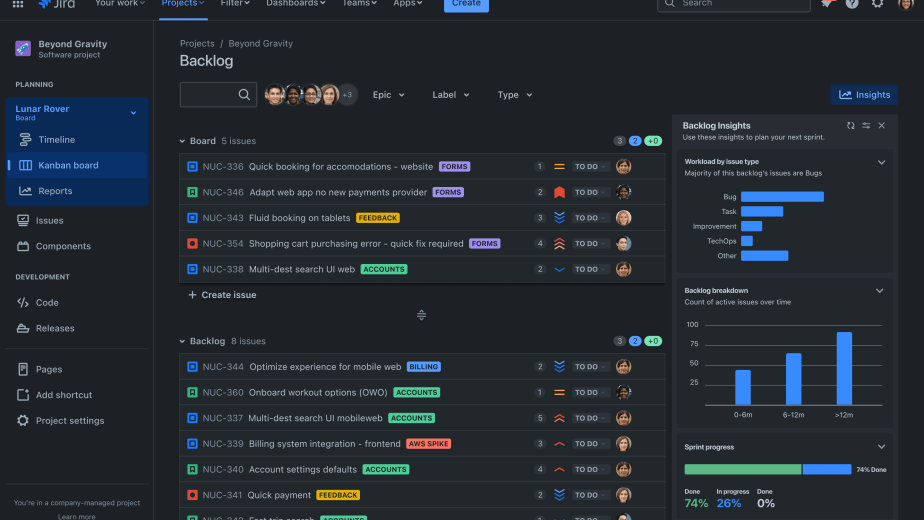In modern microservices architectures, managing traffic routing, load balancing, and SSL termination across multiple services becomes increasingly complex. Traditional reverse proxies like nginx require manual configuration updates every time services are added, removed, or modified. Traefik solves this challenge by providing automatic service discovery, dynamic configuration, and seamless SSL certificate management, making it an essential component for cloud-native applications.
This technical guide explores Traefik’s capabilities, migration strategies from nginx, and implementation patterns for microservices architectures.
tldr; You pronounce Traefik like the regular word Traffic (/ˈtræfɪk/)
What is Traefik?
Traefik is a modern reverse proxy and load balancer designed specifically for microservices and containerized applications. Unlike traditional reverse proxies that require static configuration files, Traefik automatically discovers services and configures routing rules dynamically. This makes it particularly well-suited for environments where services are frequently deployed, scaled, or updated.
Core Capabilities
Automatic Service Discovery: Traefik integrates with container orchestrators (Docker, Kubernetes, Docker Swarm), service registries (Consul, etcd), and cloud providers to automatically discover services and configure routing.
Dynamic Configuration: Routing rules, middleware, and load balancing configurations are updated automatically without requiring proxy restarts or configuration file modifications.
SSL/TLS Management: Automatic SSL certificate provisioning and renewal using Let’s Encrypt or other ACME-compliant certificate authorities.
Load Balancing: Multiple load balancing algorithms including round-robin, weighted round-robin, and least connections.
Health Checks: Automatic health monitoring and traffic routing based on service health status.
Microservices Architecture Benefits
Service Discovery Integration
Traefik excels in microservices environments by automatically discovering services through various providers:
# Docker Compose with Traefik labels
version: '3.8'
services:
traefik:
image: traefik:v3.0
command:
- --providers.docker=true
- --providers.docker.exposedbydefault=false
- --entrypoints.web.address=:80
- --entrypoints.websecure.address=:443
- --certificatesresolvers.letsencrypt.acme.email=admin@example.com
- --certificatesresolvers.letsencrypt.acme.storage=/acme.json
- --certificatesresolvers.letsencrypt.acme.httpchallenge.entrypoint=web
ports:
- "80:80"
- "443:443"
volumes:
- /var/run/docker.sock:/var/run/docker.sock:ro
- ./acme.json:/acme.json
networks:
- microservices
user-service:
image: user-service:latest
labels:
- "traefik.enable=true"
- "traefik.http.routers.user-service.rule=Host(`api.example.com`) && PathPrefix(`/users`)"
- "traefik.http.routers.user-service.entrypoints=websecure"
- "traefik.http.routers.user-service.tls.certresolver=letsencrypt"
networks:
- microservices
order-service:
image: order-service:latest
labels:
- "traefik.enable=true"
- "traefik.http.routers.order-service.rule=Host(`api.example.com`) && PathPrefix(`/orders`)"
- "traefik.http.routers.order-service.entrypoints=websecure"
- "traefik.http.routers.order-service.tls.certresolver=letsencrypt"
networks:
- microservices
Dynamic Load Balancing
Traefik automatically handles load balancing across multiple instances of the same service:
# Multiple instances with automatic load balancing
services:
api-service:
image: api-service:latest
deploy:
replicas: 3
labels:
- "traefik.enable=true"
- "traefik.http.routers.api.rule=Host(`api.example.com`)"
- "traefik.http.routers.api.entrypoints=websecure"
- "traefik.http.routers.api.tls.certresolver=letsencrypt"
- "traefik.http.services.api.loadbalancer.server.port=8080"
Migration from Nginx
Configuration Comparison
Traditional Nginx Configuration:
upstream user_service {
server user-service-1:8080;
server user-service-2:8080;
server user-service-3:8080;
}
upstream order_service {
server order-service-1:8080;
server order-service-2:8080;
}
server {
listen 80;
server_name api.example.com;
location /users {
proxy_pass http://user_service;
proxy_set_header Host $host;
proxy_set_header X-Real-IP $remote_addr;
}
location /orders {
proxy_pass http://order_service;
proxy_set_header Host $host;
proxy_set_header X-Real-IP $remote_addr;
}
}
Equivalent Traefik Configuration:
# traefik.yml
api:
dashboard: true
insecure: true
entryPoints:
web:
address: ":80"
websecure:
address: ":443"
providers:
docker:
exposedByDefault: false
certificatesResolvers:
letsencrypt:
acme:
email: admin@example.com
storage: /acme.json
httpChallenge:
entryPoint: web
Migration Strategy
Phase 1: Parallel Deployment Deploy Traefik alongside nginx with different ports to validate functionality:
# docker-compose.yml
services:
nginx:
image: nginx:alpine
ports:
- "8080:80"
volumes:
- ./nginx.conf:/etc/nginx/nginx.conf
traefik:
image: traefik:v3.0
ports:
- "80:80"
- "443:443"
# ... Traefik configuration
Phase 2: Gradual Service Migration Move services one by one from nginx to Traefik:
# Migrate user-service first
services:
user-service:
labels:
- "traefik.enable=true"
- "traefik.http.routers.user-service.rule=Host(`api.example.com`) && PathPrefix(`/users`)"
- "traefik.http.routers.user-service.entrypoints=websecure"
- "traefik.http.routers.user-service.tls.certresolver=letsencrypt"
Phase 3: Complete Migration Once all services are validated, remove nginx and route all traffic through Traefik.
Automatic SSL Certificate Management
Let’s Encrypt Integration
Traefik provides seamless integration with Let’s Encrypt for automatic SSL certificate provisioning and renewal:
# traefik.yml
certificatesResolvers:
letsencrypt:
acme:
email: admin@example.com
storage: /acme.json
httpChallenge:
entryPoint: web
# Alternative: DNS challenge for wildcard certificates
# dnsChallenge:
# provider: cloudflare
# delayBeforeCheck: 60s
Certificate Management Features
Automatic Renewal: Certificates are automatically renewed before expiration without service interruption.
Wildcard Certificates: Support for wildcard certificates using DNS challenges:
# Wildcard certificate configuration
certificatesResolvers:
wildcard:
acme:
email: admin@example.com
storage: /acme.json
dnsChallenge:
provider: cloudflare
delayBeforeCheck: 60s
Multiple Certificate Authorities: Support for different CAs per domain:
certificatesResolvers:
letsencrypt:
acme:
email: admin@example.com
storage: /acme.json
httpChallenge:
entryPoint: web
zerossl:
acme:
email: admin@example.com
storage: /acme-zerossl.json
caServer: https://acme.zerossl.com/v2/DV90
httpChallenge:
entryPoint: web
Advanced Routing and Middleware
Path-Based Routing
Traefik supports sophisticated routing rules based on various criteria:
# Complex routing example
services:
api-gateway:
image: api-gateway:latest
labels:
- "traefik.enable=true"
- "traefik.http.routers.api-v1.rule=Host(`api.example.com`) && PathPrefix(`/v1`)"
- "traefik.http.routers.api-v1.entrypoints=websecure"
- "traefik.http.routers.api-v1.tls.certresolver=letsencrypt"
- "traefik.http.routers.api-v1.middlewares=api-v1-stripprefix"
- "traefik.http.routers.api-v2.rule=Host(`api.example.com`) && PathPrefix(`/v2`)"
- "traefik.http.routers.api-v2.entrypoints=websecure"
- "traefik.http.routers.api-v2.tls.certresolver=letsencrypt"
- "traefik.http.routers.api-v2.middlewares=api-v2-stripprefix"
- "traefik.http.middlewares.api-v1-stripprefix.stripprefix.prefixes=/v1"
- "traefik.http.middlewares.api-v2-stripprefix.stripprefix.prefixes=/v2"
Middleware Chain
Traefik supports middleware chaining for complex request processing:
# Middleware configuration
services:
web-service:
image: web-service:latest
labels:
- "traefik.enable=true"
- "traefik.http.routers.web.rule=Host(`app.example.com`)"
- "traefik.http.routers.web.entrypoints=websecure"
- "traefik.http.routers.web.tls.certresolver=letsencrypt"
- "traefik.http.routers.web.middlewares=chain@file"
# Middleware chain
- "traefik.http.middlewares.chain.chain.middlewares=auth,rate-limit,compression"
# Individual middleware
- "traefik.http.middlewares.auth.basicauth.users=admin:$$2y$$10$$..."
- "traefik.http.middlewares.rate-limit.ratelimit.burst=100"
- "traefik.http.middlewares.compression.compress=true"
Cloud-Native Integration
Kubernetes Integration
Traefik provides native Kubernetes support through Ingress resources:
# kubernetes-ingress.yaml
apiVersion: traefik.containo.us/v1alpha1
kind: IngressRoute
metadata:
name: api-ingress
namespace: default
spec:
entryPoints:
- websecure
routes:
- match: Host(`api.example.com`) && PathPrefix(`/users`)
kind: Rule
services:
- name: user-service
port: 8080
middlewares:
- name: auth
- match: Host(`api.example.com`) && PathPrefix(`/orders`)
kind: Rule
services:
- name: order-service
port: 8080
tls:
certResolver: letsencrypt
Service Mesh Integration
Traefik integrates with service mesh solutions like Istio:
# istio-gateway.yaml
apiVersion: networking.istio.io/v1alpha3
kind: Gateway
metadata:
name: traefik-gateway
spec:
selector:
app: traefik
servers:
- port:
number: 80
name: http
protocol: HTTP
hosts:
- "*.example.com"
- port:
number: 443
name: https
protocol: HTTPS
tls:
mode: SIMPLE
credentialName: traefik-tls
hosts:
- "*.example.com"
Performance and Scalability
Load Balancing Algorithms
Traefik supports multiple load balancing strategies:
# Load balancing configuration
services:
api-service:
image: api-service:latest
labels:
- "traefik.enable=true"
- "traefik.http.routers.api.rule=Host(`api.example.com`)"
- "traefik.http.routers.api.entrypoints=websecure"
- "traefik.http.routers.api.tls.certresolver=letsencrypt"
- "traefik.http.services.api.loadbalancer.server.port=8080"
# Round-robin (default)
- "traefik.http.services.api.loadbalancer.healthcheck.path=/health"
- "traefik.http.services.api.loadbalancer.healthcheck.interval=30s"
Health Checks and Circuit Breakers
# Health check and circuit breaker configuration
services:
resilient-service:
image: resilient-service:latest
labels:
- "traefik.enable=true"
- "traefik.http.routers.resilient.rule=Host(`api.example.com`)"
- "traefik.http.routers.resilient.entrypoints=websecure"
- "traefik.http.routers.resilient.tls.certresolver=letsencrypt"
- "traefik.http.routers.resilient.middlewares=circuit-breaker"
- "traefik.http.middlewares.circuit-breaker.circuitbreaker.expression=NetworkErrorRatio() > 0.3"
- "traefik.http.middlewares.circuit-breaker.circuitbreaker.checkPeriod=10s"
- "traefik.http.middlewares.circuit-breaker.circuitbreaker.fallbackDuration=30s"
Monitoring and Observability
Metrics Integration
Traefik provides comprehensive metrics for monitoring:
# Metrics configuration
api:
dashboard: true
insecure: true
metrics:
prometheus:
addEntryPointsLabels: true
addServicesLabels: true
addRoutersLabels: true
accessLog:
format: json
fields:
defaultMode: keep
names:
ClientUsername: drop
headers:
defaultMode: keep
names:
User-Agent: keep
Authorization: drop
Prometheus Integration
# prometheus.yml
global:
scrape_interval: 15s
scrape_configs:
- job_name: 'traefik'
static_configs:
- targets: ['traefik:8080']
metrics_path: /metrics
Security Considerations
TLS Configuration
# TLS configuration
tls:
options:
default:
sslProtocols:
- "TLSv1.2"
- "TLSv1.3"
cipherSuites:
- "TLS_ECDHE_RSA_WITH_AES_256_GCM_SHA384"
- "TLS_ECDHE_RSA_WITH_CHACHA20_POLY1305"
- "TLS_ECDHE_RSA_WITH_AES_128_GCM_SHA256"
minVersion: "VersionTLS12"
maxVersion: "VersionTLS13"
Authentication Middleware
# Basic authentication
services:
protected-service:
image: protected-service:latest
labels:
- "traefik.enable=true"
- "traefik.http.routers.protected.rule=Host(`secure.example.com`)"
- "traefik.http.routers.protected.entrypoints=websecure"
- "traefik.http.routers.protected.tls.certresolver=letsencrypt"
- "traefik.http.routers.protected.middlewares=auth"
- "traefik.http.middlewares.auth.basicauth.users=admin:$$2y$$10$$..."
Best Practices
Configuration Management
- Use Labels for Service Configuration: Prefer Docker labels over static configuration files for better maintainability.
- Implement Health Checks: Always configure health checks for services to enable proper load balancing.
- Use Middleware Chains: Combine multiple middleware for complex request processing.
- Monitor Certificate Expiration: Set up alerts for certificate renewal failures.
Production Deployment
# Production-ready Traefik configuration
version: '3.8'
services:
traefik:
image: traefik:v3.0
restart: unless-stopped
security_opt:
- no-new-privileges:true
ports:
- "80:80"
- "443:443"
environment:
- TZ=UTC
volumes:
- /var/run/docker.sock:/var/run/docker.sock:ro
- ./traefik.yml:/traefik.yml:ro
- ./acme.json:/acme.json
command:
- --api.dashboard=true
- --api.insecure=false
- --providers.docker=true
- --providers.docker.exposedbydefault=false
- --entrypoints.web.address=:80
- --entrypoints.websecure.address=:443
- --certificatesresolvers.letsencrypt.acme.email=admin@example.com
- --certificatesresolvers.letsencrypt.acme.storage=/acme.json
- --certificatesresolvers.letsencrypt.acme.httpchallenge.entrypoint=web
- --metrics.prometheus=true
- --accesslog=true
- --accesslog.format=json
networks:
- traefik
labels:
- "traefik.enable=true"
- "traefik.http.routers.traefik.rule=Host(`traefik.example.com`)"
- "traefik.http.routers.traefik.entrypoints=websecure"
- "traefik.http.routers.traefik.tls.certresolver=letsencrypt"
- "traefik.http.routers.traefik.service=api@internal"
networks:
traefik:
external: true
Final thoughts
Traefik represents a significant advancement in reverse proxy technology, specifically designed for modern microservices architectures. Its automatic service discovery, dynamic configuration, and seamless SSL management make it an ideal choice for cloud-native applications.
The migration from traditional reverse proxies like nginx is straightforward and can be done incrementally, minimizing risk while providing immediate benefits. The automatic SSL certificate management alone can significantly reduce operational overhead, while the dynamic configuration capabilities enable true cloud-native deployment patterns.
For software architects and engineers building microservices architectures, Traefik provides the infrastructure foundation needed to support scalable, maintainable, and secure applications. Its integration with container orchestrators, service meshes, and monitoring systems makes it a comprehensive solution for modern application delivery.
The combination of ease of use, powerful features, and extensive ecosystem integration positions Traefik as the go-to choice for organizations embracing cloud-native architectures and microservices patterns.



